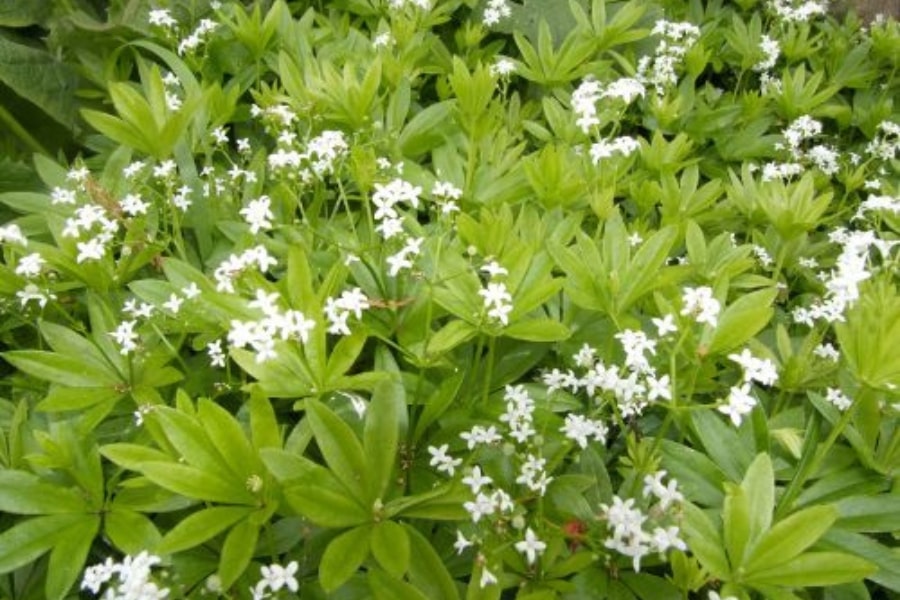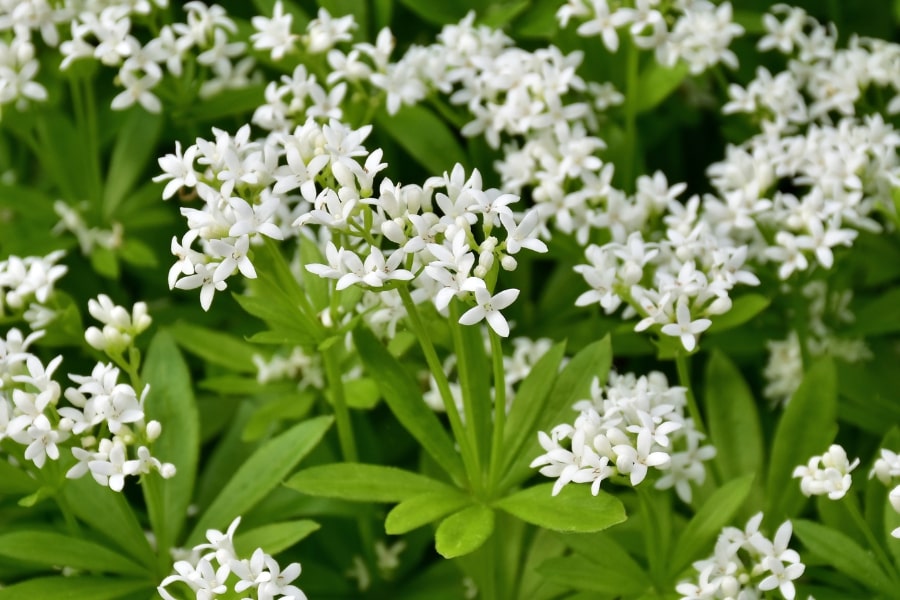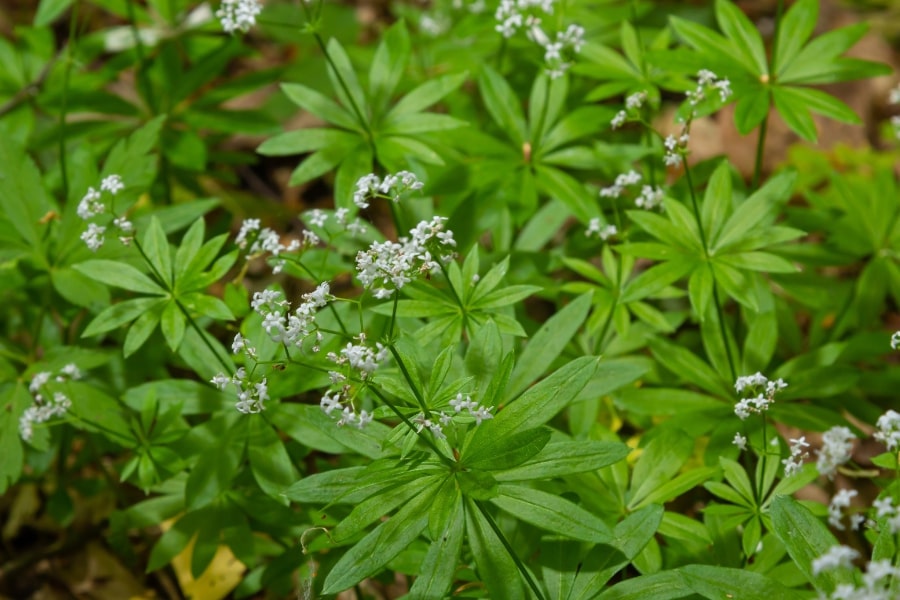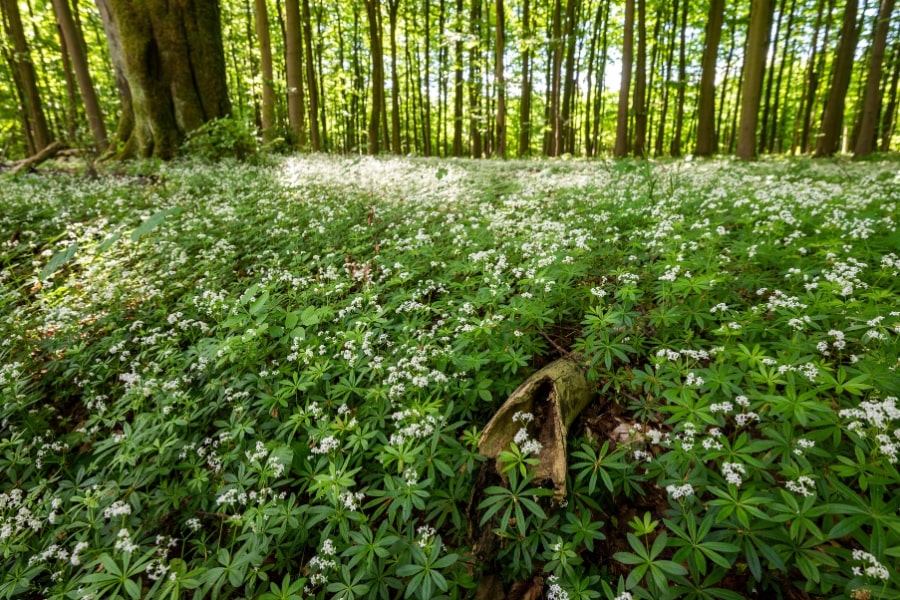Sweet Woodruff (Galium odoratum), also known as bedstraw or wild baby’s breath, is a delightful perennial herb cherished for centuries for its aromatic qualities and versatility in the garden. Belonging to the Rubiaceae family, this low-maintenance plant is native to Europe, North Africa, and Western Asia. Its scientific name, Galium odoratum, hints at one of its most distinctive features—the sweet, hay-like fragrance emitted by its narrow, lance-shaped leaves when crushed.

Growing and Caring for Sweet Woodruff
- Sweet Woodruff thrives in partial to full shade, making it ideal for shaded or woodland gardens. When selecting a location, consider areas under trees, along building foundations, or in spots with dappled sunlight.
- The plant prefers well-draining soil that is consistently moist. While sweet woodruff can adapt to various soil types, it generally favors slightly acidic to neutral soils. Adding organic matter to the soil before planting can enhance its fertility and water retention.
- Plant sweet woodruff in the spring or fall, allowing it to establish itself before the onset of extreme temperatures. When planting, space the young plants about 12 to 18 inches apart to allow for their spreading growth habit.
- Water the newly planted sweet woodruff thoroughly and maintain consistent moisture levels throughout its growing season. While the plant appreciates moisture, it is crucial to avoid waterlogged conditions, as sweet woodruff is susceptible to root rot in overly wet soil. Mulching around the plant helps retain moisture and regulates soil temperature.
- Sweet woodruff is a low-maintenance herb, but some care ensures its health and aesthetic appeal. Regular pruning is beneficial, especially after the plant flowers in late spring to early summer. Trimming back the stems helps control the plant’s spread and maintain a neat appearance.
- Division can be performed every few years to rejuvenate older clumps, encourage new growth, and prevent overcrowding. This process involves lifting established plants, dividing them into smaller sections with roots attached, and replanting them in well-prepared soil.
- Sweet Woodruff is generally resistant to many pests and diseases, making it a hassle-free addition to your garden. However, it’s essential to monitor for common garden pests, such as aphids or spider mites, and take prompt action if an infestation occurs.

Leaves and Flowers
The lance-shaped leaves of sweet woodruff are arranged in whorls along the stems, forming a distinctive, tiered pattern. The leaves are dark green and have a smooth texture. What sets sweet woodruff apart is its pleasant fragrance, reminiscent of fresh hay or newly mown grass, which is released when the leaves are crushed. This aromatic quality makes sweet woodruff an excellent choice for edging pathways or near seating areas, where the fragrance can be enjoyed up close.
Sweet woodruff produces clusters of tiny, white, star-shaped flowers in late spring to early summer. The delicate blooms add a touch of elegance to the plant and attract pollinators like bees and butterflies. While the individual flowers may be small, their collective display creates a charming effect. The combination of fragrant foliage and dainty blossoms makes sweet woodruff a multifaceted addition to any garden.

Uses in the Garden
Sweet Woodruff offers a plethora of uses in the garden, making it a versatile and valuable plant for horticulturists and landscape designers. Its ground-covering habit makes it an excellent choice for shaded areas under trees or alongside buildings, where it can create a lush, green carpet. The fragrance emitted by the leaves adds an olfactory dimension to garden spaces, making it a popular choice for sensory gardens or areas meant for relaxation.
If you have limited garden space or prefer container gardening, sweet woodruff can be successfully grown in pots. Select a container with drainage holes and use a well-draining potting mix. Place the container in a shaded or partially shaded location, such as a patio or balcony. Regular watering is essential to keep the soil consistently moist, as container-grown plants may dry out more quickly than those in the ground. Container gardening allows you to enjoy the beauty and fragrance of sweet woodruff in small spaces, bringing its charm to patios, balconies, or even indoors as a potted herb.

Frequently Asked Questions
Can Sweet Woodruff Be Grown in Full Sun?
While sweet woodruff prefers partial to full shade, it can tolerate some morning sun or dappled sunlight. However, protecting the plant from intense afternoon sun is crucial, as prolonged exposure can lead to leaf scorch. In hotter climates, providing afternoon shade becomes even more important to maintain the plant’s health and vigor.
How Do I Propagate Sweet Woodruff?
Sweet woodruff can be easily propagated through division. In early spring or fall, lift established plants and separate them into smaller sections, ensuring each division has roots attached. Replant the divisions in well-prepared soil, water thoroughly, and keep them consistently moist until they establish themselves. This method not only helps propagate the plant but also rejuvenates older clumps.
Is Sweet Woodruff Invasive?
While sweet woodruff can spread and form dense mats, it is not typically considered invasive in the aggressive sense. Its growth can be managed through regular pruning and division. The plant’s ability to fill spaces makes it an excellent ground cover, but its spreading habit may need monitoring in smaller garden settings.
Is Sweet Woodruff Toxic to Cats and Dogs?
Sweet Woodruff contains coumarin, a natural compound that can be toxic to dogs if ingested in large quantities. Coumarin is known to have anticoagulant properties, which can affect blood clotting. While sweet woodruff is generally considered low toxicity, it’s essential to exercise caution, especially if you have dogs prone to nibbling on plants.
